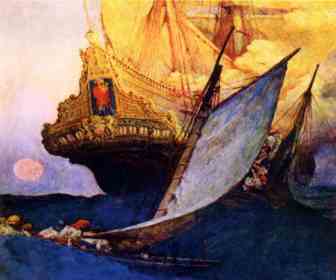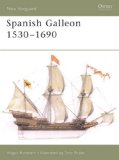More Pirate Pages
Pirate Fun
Pirate Galleon Info- The Pirate's Realm

A galleon was a large, multi-decked sailing ship used primarily by the nations of Europe from the 16th to 18th centuries. Whether used for war or commerce, they were generally armed with cannons.

Pirate galleons were an evolution of the caravel and carrack (or nao), for the new great ocean going voyages. A lowering of the forecastle and elongation of the hull gave an unprecedented level of stability in the water, and reduced wind resistance at the front, leading to a faster, more maneuverable vessel. The pirate galleon differed from the older types primarily by being longer, lower and narrower, with a square tuck stern instead of a round tuck, and by having a snout or head projecting forward from the bows below the level of the forecastle. In Portugal at least, carracks were usually very large ships for their time (often over 1000 tons), while galleons were mostly under 500 tons, although the Manila galleons were to reach up to 2000 tons. Carracks tended to be lightly armed and used for transporting booty from the Far East, while galleons were purpose-built warships, and were stronger, more heavily armed, and also cheaper to build (5 galleons could cost around the same as 3 carracks) and were therefore a much better investment for use as warships. There are nationalistic disputes about the origin of the galleon, which are complicated by its evolutionary development, but each Atlantic sea-power developed types suited to their needs, while constantly learning from their rivals.
The pirate galleon was powered entirely by sail, carried on three to five masts, with a lateen sail continuing to be used on the last (usually third) mast. They were used in both military and trade applications, most famously in the Spanish treasure fleet, and the Manila Galleons. In fact, galleons were so versatile that a single vessel may have been refitted for wartime and peacetime roles several times during its lifespan. The galleon was the prototype of all three or more masted, square rigged ships, for over two and a half centuries, including the later full-rigged ship.
This Pirate Galleon artickle: Wikipedia contributors (2006). Galleon. Wikipedia, The Free Encyclopedia. Retrieved 22:15, May 6, 2006 from http://en.wikipedia.org/w/index.php?title=Galleon&oldid=50281025.
Pirate Galleon Info
These famous trade and treasure ships designed by the Spanish shunned the low-armament idea of other merchant vessels and were truly a force to be reckoned with; although that could not completely deter pirates attracted to the immense wealth they contained. With a crew upwards of 200 manning two or three decks of over 70 cannon, numerous swing guns, and even archers' platforms on the three or four masts, this virtual man-of-war would use resistance only as a last but fearsome resort - broadsides were deadly. Still, the pirates came after it, because the top speed of around eight knots could not begin to compensate for quirky design features which made it difficult or impossible to maneuver well in less than ideal seas. Massive square sails that prevented sailing into the wind, the hull broad at bottom and narrow at top that failed to lower its high center of gravity, and a tiny keel all conspired to make it behave more like a washtub than a warship, and someone was always waiting to drain it dry.
Before the galleon, the Spanish and Portuguese sailed huge carracks on their trade routes. These well-armed three-masted ships were the biggest around and could reach over 1100 tons. A carrack could most always fend for itself against pirates.
See also our page about all pirate ships.

